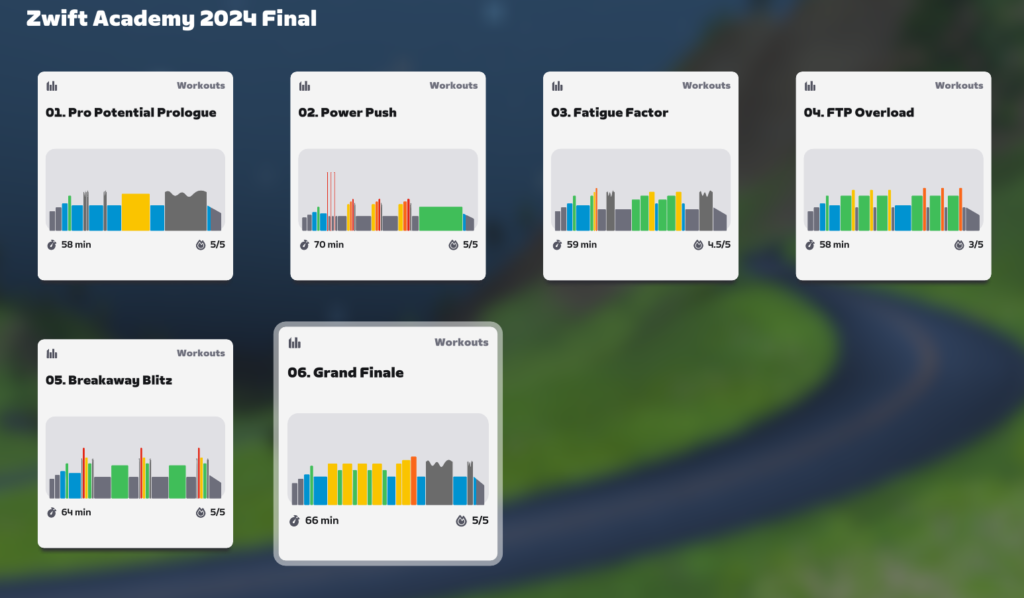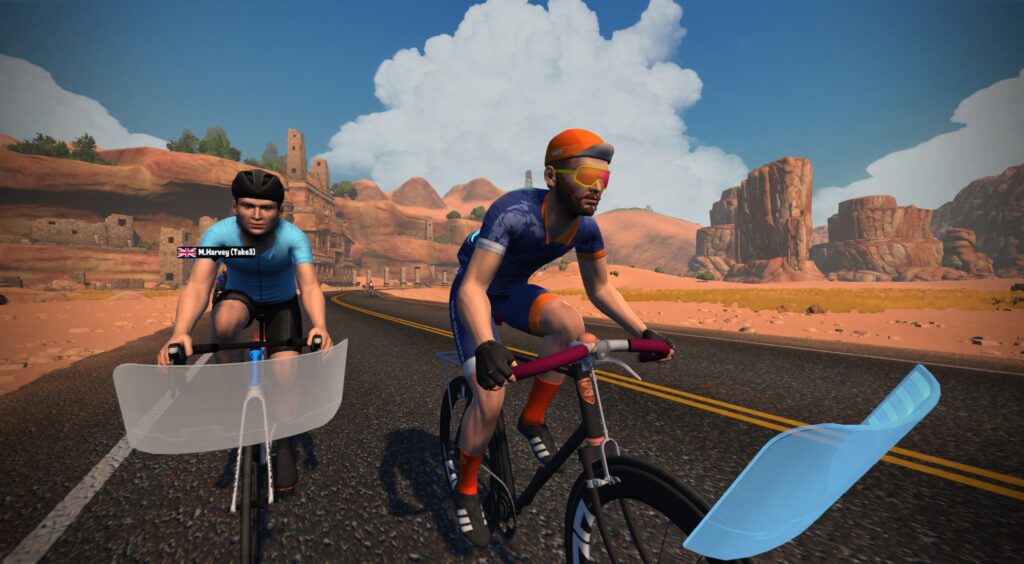About this Series
Zwift is a virtual cycling playground with nearly infinite possibilities. What new things could the platform support, if Zwift invested the resources to make it happen?
That’s what I’m exploring in this series of articles. Each post focuses on a particularly compelling idea for a new Zwift feature or event type that doesn’t yet exist. I dig into how it could work, why Zwifters might love it, and what Zwift may need to change in the game to make it happen.
Today, we take a look at what could be done to make Zwift Academy a more engaging offering for the everyday Zwifter.
Zwift Academy Basics
Zwift Academy began in April 2016 with the goal of recruiting one female Zwifter for the 2017 Canyon//SRAM women’s pro racing team. Leah Thorvilson won that inaugural contract (read our interview with Leah), and after another women’s-only Academy in 2017, the 2018 Zwift Academy chose both a men’s and women’s winner.
While Zwift has held Academies for triathletes and runners, it’s the cycling academies that have always been the most popular. Zwift has held one every year since 2016, making 2024’s Academy the 9th in the series.
To graduate from Zwift Academy, riders typically have to finish a set of workouts and possibly a race or two within a stated time window. Zwift Academy has always been very popular with the community, even though the vast majority of riders aren’t in a position to vie for a professional cycling contract. Over 108,000 riders participated in Zwift Academy 2023!
But there’s always been a tension between Zwift Academy as a talent ID program and Zwift Academy as a training program for the everyday Zwifter. Each year Zwift has tweaked the program to try to maintain the difficult balance between giving community riders an introduction to structured training, while providing the kind of fitness testing needed to identify the world’s top riders.
Zwift Academy 2024, which just kicked off last week, sees Zwift moving noticeably toward the talent ID side of the program. They’ve done away with the shorter (easier) workouts and made the workouts available on-demand only. The completion window is much larger so more riders can tackle the program at peak fitness. And the 6 required workouts are clearly fitness tests, not a training program of any sort:

While some community members are lamenting the loss of the community side of Zwift Academy, I can’t fault Zwift for wanting to push the talent ID aspect of the program. And the truth is, to focus on talent ID, you really have to walk away from the community training side of years past.
Because highly talented racers don’t need to go through any sort of Zwift training program to be identified. (And on the flip side, community riders don’t really benefit from completing a series of one-off pro-level fitness tests.)
As I’ve pondered the evolution of Zwift Academy, what I’ve settled on is this: it needs to become two programs. One program is the annual talent ID competition. The other is a community-friendly training program that any rider can follow to build fitness, learn training fundamentals, and learn about Zwift as a training platform.
For the purpose of this post, we’ll say the Talent ID competition keeps the Zwift Academy name. Let’s call the community-friendly program I’m proposing “Zwift Community College”, or ZCC for short. (It’s a working title.)
Zwift Community College Basics
Off the top of my head, I can think of several ways the ZCC program could be structured to offer a better training opportunity to the Zwift community than Zwift Academy currently offers. But let’s focus on my favorite approach: a year-round, progressive training program made up of 13 four-week blocks. Here’s how it could work:
- Each four-week block would be its own training unit. Completing a unit would earn a badge or other achievement, similar to finishing a college class.
- Each week would consist of 2-3 difficult workouts interspersed with 2-3 optional recovery workouts. Even an occasional race could be required.
- To ensure a safe fitness progression, riders would be required to complete key workouts in a particular order for each unit. Some workouts (especially the recovery rides) would be optional for unit completion.
- In keeping with standard training practices, the fourth week of each unit would be a recovery week consisting of fewer, less difficult workouts.
- Training blocks would be planned for the full year with thought given to overall fitness progression. That is, you might feature a lot of base work in December/January, progressing riders to race-ready fitness by May/June.
- Workouts would be available on-demand or as group events.
- Workouts would be well-documented, so riders could know the purpose and plan of each workout before loading into the game.
The idea here isn’t to replace a high-quality training program that a seasoned cyclist may have set up with an expert coach. Rather, ZCC would be a year-round training program that would help the average non-coached rider build fitness and learn about training, all in the context of Zwift’s amazing worldwide community.
Fun For All
How can ZCC be fun for everyone? This is an important question to answer when it comes to any Zwift feature, because Zwift needs to remain an inclusive platform where everyone can find motivation and fun, regardless of fitness level.
First, it’s important to mention that structured workouts on Zwift are based on each rider’s FTP. To pull an example out of thin air: one rider may have to hold 350 watts for 5 minutes in a VO2 max interval, while another rider only has to hold 150 watts. For both riders, that interval is 115% of their FTP, which means the relative level of difficulty is approximately the same for each rider. So while everyone is doing the “same” workouts each week of each ZCC unit, in a very real sense they’re not doing the “same” workout. And that’s a good thing.
The community aspect of ZCC is important, as we tend to push ourselves harder and stick to plans better when training with others. On Zwift, group workouts run in keep-together mode, so everyone stays together regardless of what watts they’re pushing. (Plus, good news: keep-together mode was improved a few months back, so riders move at much more realistic speeds!)
Leaderboards and other competitions could be used to further engage the community around the ZCC concept. Which riders have completed the most units? Which Clubs have completed the most ZCC workouts? Where do your key fitness metrics place you in relation to other riders in your gender/age/weight group/country?

Workout of the Week Replacement
Zwift’s Workout of the Week series doesn’t seem to follow any sort of progressive training plan. Perhaps the WoW workouts could instead be pulled from that week’s ZCC workouts, allowing riders who aren’t enrolled in ZCC to experience the program and learn more about how it works.
A Progression of Progressive Training Plans
It may be a lot for Zwift to roll out a full year’s ZCC program. What if they rolled out three four-week units instead, perhaps a base training program that begins in early December?
The kinks could be worked out, then a full-year plan could come next.
Why ZCC?
Why would Zwift want to bring something like ZCC to the platform?
- Training purpose and community: Zwift’s current approach to training basically offers two options: “choose your own adventure” (via the Training Plan library) or try a one-off workout that doesn’t necessarily fit into an overall plan. The first option doesn’t include a community element, and the second doesn’t help riders progress over weeks and months in a structured manner. ZCC would fill those holes.
- Zwift Academy clarity: removing the community aspect of Zwift Academy allows that program to clearly function as a talent ID program.
- More achievements: many Zwifters like to chase achievement badges and unlocks. ZCC would provide another way to do this as riders earn an achievement upon completing each 4-week unit.
- A new way to train: as far as I know, a concept like ZCC hasn’t been implemented on any virtual cycling platform. Could you imagine 100,000 riders all taking part in the same year-round training program? What sort of cool stuff could be done with a community like that, and what sort of training movement would that create in the worldwide cycling community?
Required Game Changes
What would Zwift need to implement in order to make ZCC a reality? It could happen in a basic way today, with a little planning. Zwift could simply create/choose the workouts for each unit, set up events for those workouts, and make those workouts available in your on-demand folders.
That would be a very basic implementation, though. To really do it as I’ve described above, Zwift would need to do some additional work:
- High-Quality Workout Library: Zwift already hosts many workouts, some of which are better than others. Chances are, a good number of new workouts would need to be created to fill a full year’s progressive training program with sessions that follow best training practices.
- Completion Logic: Zwift would need a way to mark certain key workouts as required so riders have to finish them before going on to the next week.
- Scheduling Logic: the game would need to present upcoming workouts in a way that makes it easy for riders to choose what to do next.
- Achievement Assets: if riders will be unlocking badges or other assets at the end of each unit, those assets will need to be created by Zwift’s art team.
- Leaderboards: fun stuff like fitness leaderboards would need to be built to bring an additional level of community interaction and competition into ZCC.
Your Thoughts
What do you think – does Zwift Academy need to become two programs? Would you attend Zwift Community College? Share below!